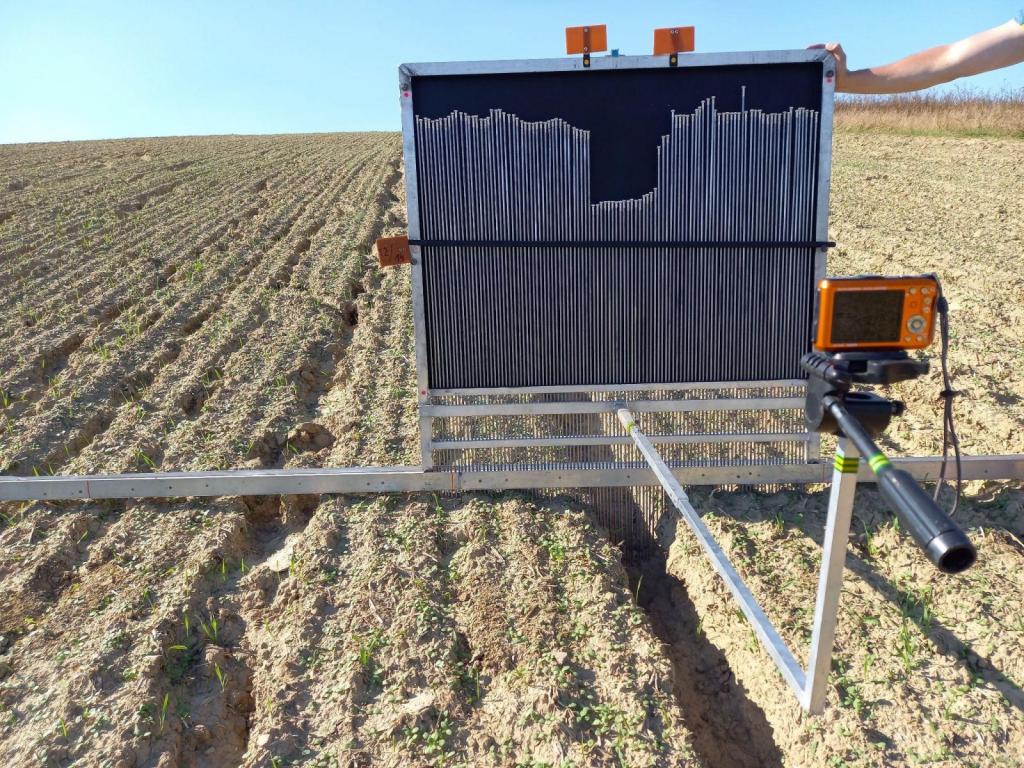Ideas and discoveries
Software as a bachelor thesis helps with soil erosion research

When Veronika Sobotková and her colleagues from the Faculty of Civil Engineering of BUT go out to make field measurements, she returns with dozens of photographs. On all of them there is a so-called erodometer, which can be described as a large frame with needles that lower to the ground and show the profile of soil damaged by erosion. "Erodometer is a device that was designed and manufactured by the Institute of Landscape Water Management. It allows the measurement of the soil surface profile and the quantification of the volume of erosion grooves that can occur on sloping land after torrential rains. Hundreds of erosion groove profiles were surveyed directly in the field with results many times exceeding the permissible soil losses," explains Sobotková.
In a single day of field measurements, about one hundred to one hundred and sixty photographs are created. Each had to be processed manually: in the computer, manually clicking the vertices of all the needles in the image, creating a curve from them and comparing it with the previous results. Dealing with one photograph in this way took about ten minutes.
The software can process one photo in about ten seconds.
Some time ago, when Sobotková accidentally got into a conversation with Roman Adámek of the Mechatronic Laboratory of the Faculty of Mechanical Engineering of the Brno University of Technology, he offered to try to make their work connected with image processing easier. Later, FME student Lukáš Dobrovolný decided to take up this topic as his bachelor thesis.
Faster and less work-demanding
"I was intrigued by the topic, it concerned the issue of image processing," says Dobrovolny. He created a special software for image processing that can process one picture in about ten seconds. "I use the contrast between the black background and the light needles. I convert the picture to a binary image and an algorithm then detects the tops of the needles. In case some of them fail to get detected – for example, due to lighting conditions or when a leaf obstructs the shot – the user still has the option to manually correct the points. Even so, it is a great time saving, because there are about a hundred needles in the frame, "says Dobrovolny.

"I find it inspiring that this is an issue from a completely different field, which we were able to solve thanks to our knowledge of image processing. The student himself came up with a proposal on how to solve the detection of needles in the image, together we just fine-tuned the details. Colleagues from the Faculty of Civil Engineering compared the new software with the accuracy of the existing method and both procedures came out similarly accurate – with the difference that the manual method is incomparably more laborious, "adds the Supervisor of the bachelor thesis Roman Adámek.
His words are confirmed by Veronika Sobotková, who estimates the time savings in processing one photograph of around ten minutes. Her team will then have more time to research the hot topic of soil erosion. "Based on the erosion bridge measurements, we determined various patterns of erosion groove formation, parameters of emerging grooves and prediction of their occurrence. Based on our research and cooperation with the T. G. Masaryk Water Research Institute, the Critical Points Methodology was created, according to which critical points are determined, indicating that it is necessary to initiate anti-erosion and flood protection measures at the given location," concludes Sobotková.
Women from BUT who move the world of science and technology
Greener brickmaking: New technologies from FCE BUT reduce carbon footprint
Hybrid pallets save nature. Experts from FME BUT are also helping with the development of Flexipal
Waste is science. Thanks to experts from BUT, the Czech Republic has a forecast of their production
Science: Changes in waste management could buy us time to tackle the climate crisis